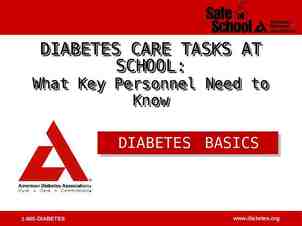Handoffs National Pediatric Nighttime Curriculum Written by Shilpa
25 Slides493.00 KB

Handoffs National Pediatric Nighttime Curriculum Written by Shilpa Patel and Lauren Destino Stanford University

Case 1 The handoff from your fellow intern: “Your first patient is Will, a 4 yo with asthma, probably going home tomorrow, so nothing to do. Is still on a little oxygen, but try to wean it overnight so he can actually go home, ok?”

Case 1 Are you ok with this information? Do you think you have all you need to take care of this patient overnight? What can you do to improve this communication? What if the nurse calls you and states Will is needing more oxygen?

Case 2 The handoff from your fellow senior: “The sickest patient is Mackenzie. She is a 3 yo ex-preemie with CP, developmental delay, chronic lung disease who is here with pneumonia. She just came up from the ED and her main issue is respiratory distress. She is on continuous albuterol at 15mg/hr, IV clinda and ceftriaxone and IVF. I would look at her right after sign out since if she gets a lot worse, the PICU may need to be consulted.”

Case 2 Are you ok with this information? Do you think you have all you need to take care of this patient overnight? What can you do to improve this communication? What will you discuss with the intern? What would you do if you get a page about this patient in the middle of the hand off?

Objectives To recognize effective vs. ineffective handoffs To identify the components of an effective handoff To understand the importance of communication to patient care

Why Should We Care? Institute of Medicine estimates up to 100,000 patients die in U.S. hospitals annually due to errors in their care. Failures in communication a leading cause of adverse events in healthcare. Issues around communication, continuity of care, or care planning cited as root cause in 80% of reported sentinel events. Australian review of 28 hospitals found communication errors associated with twice as many deaths as clinical inadequacy. Coverage by a second team of residents one of strongest predictors of adverse outcome

Sentinel Events Unanticipated event that results in death or serious physical or psychological injury to a patient and is not related to the natural course of the patient’s illness

Why Now? More turnover of patients and personnel: Increase in rate of transfers and discharges by 40% since duty hour changes made New duty hours: average of 15 handovers during a 5-day hospitalization Each intern involved in 300 handovers in average monthlong rotation 12 13 Healthcare more specialized: 12 Greater number of clinicians providing narrow focus of care Specialized units designed for specific diseases, procedures, phases of illness may mean loss of big clinical picture Increase in rate of discontinuity 13 Changes in the resident schedule structure to reduce fatigue Cultural change in healthcare delivery that utilizes schedules with shifts Many points of transitions, transfers of responsibility (MD to MD, RN to RN)

What do we know about communication? A recent handoff study supports literature on the psychology of miscommunication: Speakers systematically overestimate how well their message is understood by listeners Speakers also assume that the listener has all the same knowledge that they do (gets worse the better you know someone)

The Handoff Players Sender Receiver

What Works: a look at other high risk industries 3,4 Face to face: verbal, interactive questioning in safe environment Limit interruptions: so can go through handover systematically Sender provides updated printed summary Opportunities for both receiver and sender to introduce topics Information relayed in structured format: decreases omissions

What Works: a look at other high risk industries 3,4 Specific contingency plans Read back: insures info received correctly Checklist: avoids content omissions Delay transfer of responsibility when concerned about patient status Unambiguous transfer of responsibility: wards know who to call Receiver scans historical data either right before or right after the handoff

Components of Ideal Handoff Brief one liner about the patient including: How sick is the patient? Significant past medical history Reason for admission CURRENT condition, recent interventions, active problems

Components of Ideal Handoff Systematic approach to communicating needed information. Use one consistently so receiver knows what to expect. --Systems --SIGNOUT --SAFE-IR --IPASS the BATON --SBAR --Problems Contingency planning – i.e. anticipated problems, results, procedures and what to do about them: BE SPECIFIC “Read back” to verify a shared mental model

Two Way Street to a Shared Mental Picture Receiver Sender Paints picture Listens Relevant items Ask questions Specific directions with rationale Use system to remember important items Check receiver understanding Read back

Back to Case 1 Identification: Will is a 4 yo with mild persistent asthma on hospital day #2 for an asthma exacerbation, triggered by URI. He is improving and no longer very sick and should go home tomorrow if he can be weaned off oxygen overnight.

Back to Case 1 Problems Asthma: He was on continuous albuterol at 10mg/kg on admit but now weaned to 4 puffs MDI every 4 hours. He has wheezing before treatments but no retractions, flaring or work of breathing. He is on day 2 of oral steroids and on Flovent twice a day. Nutrition: He has an IV and required a bolus on admit. He is now eating and drinking well. Hypoxia: Will has needed 0.5-2L by nasal cannula and is currently down to 0.25 L with sats 95%. Infectious Disease: Will has been afebrile and his current exacerbation is thought to be due to a viral process. He is in isolation given his runny nose and cough.

Back to Case 1 Contingency Planning: If Will has an increasing oxygen requirement try increasing albuterol frequency to every 3 hours If he is febrile, recheck his lung exam to assure no focal signs concerning for a developing pneumonia Wean the oxygen as the goal is discharge tomorrow If his IV falls out there is no need to replace it Readback: Receiver repeats important information

Practice a handoff Please practice signing out the patient on the following slide using the ideal sign-out components in a pre-determined standard order The details are intentionally disorganized One person should observe the sign-out and give feedback One person should give the sign-out One person should receive the sign-out (ask questions and read back).

Practice handing off this patient JS is a 7 yo girl with known asthma who was admitted to the PICU 2 days ago. In the PICU she was on heliox, continuous albuterol and a terbutaline drip for one day. The terbutaline has been off for 15 hours, the heliox off for 24 hours. She is currently on 6 puffs every 2 hours, a 2 Liter O2 requirement, IV methylprednisolone at 4 mg/kg/day. She is also on maintenance IVF for continued poor po intake. She came to the floor this morning and was doing well until around 3 pm when the intern was called to evaluate for increasing O2 requirement. On assessment, she seemed to be aerating less on the right when compared to the left; a CXR was done but is not yet up. She was restarted on continuous albuterol at 5 mg/kg/hr. The plan is to get a gas if things continue to worsen. Also a pulmonary consult was obtained for multiple recent admissions, and for poor compliance. If they have recommendations, it is okay to follow through with them unless they seem excessive, in which case, they should be discussed with the attending. If CXR shows consolidation, antibiotics should be started. If there is concern for a pneumothorax on the CXR, talk to the senior resident and consider PICU consult for thoracentesis. She should be kept NPO due to her worsening clinical status. But if the CXR is normal and she is improving from a respiratory point of view, consider restarting diet. Currently on exam, her RR 35, she is on 10L face mask, and she is retracting and wheezing everywhere except on the right side, where there are diminished breath sounds. She can speak in 3 word sentences, which is a decline from this morning. However, she is still alert and responsive. This afternoon at 1300, she had a fever to 38.4 C; she had been afebrile at home.

Take Home Points Giving sign out: Be specific, concise and deliver the information in a standardized format. Receiving sign-out: Summarize what you were told and ask questions as needed; listen actively by anticipating potential issues. “Read back” the most salient points of the sign-out. Communication Poor communication can lead to errors, near misses and adverse events Good communication can improve quality and safety of patient care It is best not to assume knowledge

Selected References Chang VY, Arora VM, Lev-Air S, D’Arcy M, Keysar B. Interns overestimate the effectiveness of their hand-off communication. Pediatrics 2010;125(3):491-496. Arora VM, Johnson JK, Meltzer DO and Humphrey HJ. A theoretical framework and competency-based approach to improving handoffs. Qual Saf Health Care 2008; 17:11-14. Patterson ES, Roth EM, Woods DD, Chow R and Gomes JO. Handoff strategies in settings with high consequences for failure: lessons for health care operations. Intl J Qual Health Care 2004;16(2):125132

Bibliography 1. Arora V, Johnson J: A model for building a standardized hand-off protocol. J Qual Patient Safety 32(11), 646-655, Nov 2006. 2. Sidlow R, Katz-Sidlow RJ: Using a computerized sign-out system to improve physician-nurse communication. J Qual Patient Safety 32: 32-36, Jan 2006. 3. Patterson ES, et al: Handoff strategies in settings with high consequences for failure: lessons for health care operations. Intl J Qual Health Care 16(2): 125-132, 2004. 4. Arora V, Johnson J et al: Communication failures in patient sign-out and suggestions for improvement: a critical incident analysis. Qual Saf Health Care 14:401-407, Dec 2005. 5. Streitenberger K, Breen-Reid K, Harris C: Handoffs in care - can we make them safer? Pediatr Clin N Am 53:11851195, 2006. 6. Solet DJ, Norvell JM, et al: Lost in translation: challenges and opportunities in physician-to-physician communication during patient handoffs. Acad Med 80:1094-1099, 2005. 7. Williams RG, et al: Surgeon information transfer and communication. Ann Surg 245(2): 159-169, 2007. 8. Frank G, Lawless ST, Steinberg TH: Improving physician communication through an automated, integrated sign-out system. J Healthcare Info Mgmt 19(4):68-74, 2005. 9. VanEaton EG, et al: A randomized, controlled trial evaluating the impact of a computerized rounding and sign-out system on continuity of care and resident work hours. Surgery 136(1):5-13, 2004. 10. Haig, KM, et al: SBAR: a shared mental model for improving communication between clinicians. J Qual Patient Safety 32(3): 167-175, March 2006. 11. Bernstein JA, Imler DL, Longhurst CA: Physicians report improved workflow after integration of sign-out notes into the electronic medical record. Submitted for publication, transcript provided by Dr. Longhurst. 12. Patient Safety and Quality: An Evidence-Based Handbook for Nurses. (AHRQ Publication No. 08-0043) http://www.ahrq.gov/qual/nurseshdbk/

Bibliography continued 13. Vidyarthi, AF, Arora, V, Schnipper JL Managing discontinuity in academic medical centers: strategies for a safe and effective resident sign-out. Journal of Hospital Medicine 2006; 1:257-266. 14. Peterson LA, Brennan TA, O’Neill AC Does housestaff discontinuity of care increase the risk for preventable adverse events. Ann Intern Med. 1994; 121:866872. 15. Mukherjee S A precarious exchange. NEJM 2004; 351:1822-1824. 16. Chang VY, Arora VM, Lev-Air S, D’Arcy M, Keysar B. Interns overestimate the effectiveness of their hand-off communication. 2010;125(3):491-496.






